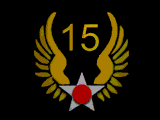|
"TUFF SHIP"
"That
engine will have to be changed and this plane has to be ready in the morning."
That was the problem that faced M/Sgt Edwin E. Nelson, Portsmouth, Ohio, crew
chief of a 721st Bomb Squadron B-24, at 2200 hours on a dark night
at a base in Italy. It's a man-sized job under the best of conditions; and when
it's done under pressure on a blacked-out airfield with only flashlights to
work with, it's a job that calls for men. All night long M/Sgt Nelson and his
crew of Sgt Norman Anderson, Sgt John I. Elliott Jr., Cpl Bernard C. Sheets,
and Pfc Chester A. Lesniak worked, making every move count. The old engine was
removed and the new one hoisted up in its place. For nine long hours these men
sweated and grunted at their job. As the cold, gray Italian dawn broke, the
crew chief climbed up onto the Liberator's flight deck as his men made the last
few adjustments. The new engine was then started and given the usual preflight
check. There was even time to "slow time" the engine before the pilot, 1st
Lt Edmund H. Wolcott, Scarsdale, New York, arrived with his flight crew for
takeoff.
The rest of
the "Tuff Ship" crew – Vic Meeker and Bob Leebody (navigator and bombardier);
Herb Huff, co-pilot; Bill Flanagan, engineer/top gunner; James R. McGown,
engineer/nose gunner; Benjamin F. Runyon, engineer/waist gunner; Robert C.
Fisher, ball turret gunner; J. R. Frank, tail gunner; and John V. Goldthwaite,
radio operator – arrived for another mission knowing that she would be ready
because for 28 consecutive missions they had heard M/Sgt Nelson's "She's ready
to go, sir." This Liberator called "Tuff Ship" holds a record in the 450th
Group. It has flown 28 consecutive missions and never turned back because of
mechanical difficulties.
The
dedication of the ground crews, represented here by M/Sgt Nelson and his men,
is the key reason that the 15th Air Force bombers are carrying
destruction into Germany day after day with the regularity of a railroad
schedule. "It's because of men like M/Sgt Nelson and his crew that the USAAF is
maintaining superiority over the Luftwaffe in the skies and knocking out his
planes on the ground in ever-increasing numbers."
- Original Sorite clipping from Vic Meeker, reprinted in
Vol. V No. 2 Sortie 1988.
THE CREW SURVIVED – THE AIRCRAFT DIED
In November
1943, "Tuff Ship" was delivered fresh from the Ford factory to its crew at
Alamogordo, New Mexico. From the U.S. they flew her to join the 450th
Bomb Group in Italy on a route through South America and Africa. From the
first, the crew and the aircraft had an affinity for each other.
Her Crew
Men in
their late teens and early twenties manned her – Ed Wolcott, a competent 22
year old captain who loved to fly; Vic Meeker and Bob Leebody, a
navigator/bombardier pair who aimed to excel; Herb Huff, who sat in the right
seat steadfast and calm-the story goes that Ed never relinquished his take-off
and landing responsibilities, but in the one great emergency with Ed out of
action, Herb performed as if he had always been number one – and he was! Herb
survived the war, as did the entire crew, and passed away in 1970. Engineer
Bill Flanagan says he had little to do other to throw a few switches and exude
confidence the aircraft would always return. He had skillful back up by Jim
McGown who also manned a gun turret. John Goldthwaite stood by his radio
through all kinds of commotion. He never sent a message from the ship and the
one time an emergency message was needed, he had to refrain because the ship
was drenched in gasoline.
Six gunnery
positions were manned most of the time. The designated ball gunner, Bob Fisher,
found the ball turret exceedingly confining for his six foot frame. He could be
more relaxed at the waist guns and teamed at times with Ben Runyan. There were
fighters from time to time and J.R. Frank manned the atil guns and knocked down
three of them. The others served to keep fighters at bay with their fire power.
"Tuff Ship"
lumbered through 67 missions, patched and repatched. Ed Nelson and his helpers
constantly crawled over the sleeping aircraft testing, patching, and repairing.
The quality and dedication of their wok was recognized early by a commendation
for the outstanding record of "Tuff Ship" in having flown 28 consecutive
missions with no early returns.
She Dies
Never
did the aircraft fail to take her crew to the target and return. Although
frequently damaged, neither flak nor fighter fire was able to bring her down.
Her demise came in an undignified manner and at that time, she had far more
missions to her credit than any sister craft. As she rested between flights,
she was rammed by another aircraft whose brakes failed on the taxi strip. Her
tail was chewed off and "Tuff Ship: was dismantled for parts. Anyhow, she was
old and worn and her mission fulfilled – her crew was safely gone from the base
and on their way home.
She had
served to bring ten men together to work as a tem and to develop a closeness
that did not require words. After 40 years with no contact, they met at
Riverside, California in 1983 at the first reunion of the 15th Air
Force. They found that they cared very much for each other despite the absence
of contact through all the years. They arrived at Riverside from different
backgrounds, hometowns, occupations, and life styles, yet the closeness forged
in combat still bound them together.
- Bill Flanagan and Vic Meeker, Sortie Magazine, Vol. VII
No. 4, 1992
|



